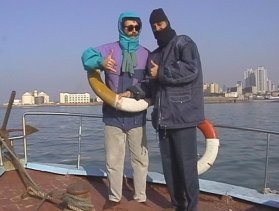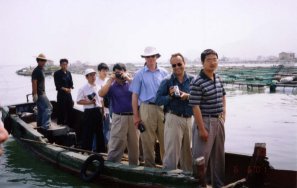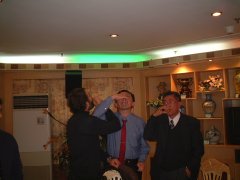Workshops
Carrying capacity and impact of aquaculture on the environment in Chinese bays
INCO-DC contract Nš ERBIC4CT 98-0291
Training sessions and workshops took place throughout the project, both in China and Europe. This included training in ecophysiology experiments, ecosystem and ecophysiology modelling and database management.
| The kick-off workshop
took place in Qingdao, China, from November 30th to December 4th 1998.
At this workshop, the project was presented to the decision-making community of Shandong Province, general presentations were made by the participants, and the project workplan was reviewed by the team. The key issues were: |
|
-
Presentation of the different partners and task allocations
-
Review of the project agenda and workplan
-
Definition of coordination and sub-groups for main tasks
This was followed by cooperative model training and experimental activities in the Spring of 1999, which took place both in Qingdao and in Rongsheng city, Shandong province.
The second annual workshop took place in Oporto, Portugal, from 8-11 November 1999. Reviews of work carried out were presented by participants, including database, GIS, modelling, fieldwork and experimental activities. Details were presented regarding training in China, and proposed courses in the year 2000 on data management and ecological modelling.
In Qingdao, a modelling workshop was held from 14-20 May 2000, which focused on capacity building for database use and modelling, both at the physiology and ecosystem scale.
An intensive training course was held from 11th to14th October 2000, at La Rochelle, France, on ecological modelling using the EcoWin2000 platform. The course, attended by about 10 scientists, was divided into three blocks: The first day for introductory aspects, 1.5 days for using the model and the remaining period for object-oriented programming for ecological modelling. During this period, the database framework which was used to store field and experimental data for Jiaozhou Bay and Sanggou Bay was also explored.
Following the course, the third annual workshop was held at La Rochelle, from the 16-18th October, 2000. The first day was used to present results, the second day for detailed planning of activities for the third project year, and the last day was reserved for the steering committee meeting and workshop conclusions. An interim project meeting was scheduled for Spring 2001 in Qingdao, to allow timely preparation of reports and final project actions.
| The Spring meeting took
place from May 31st to June 1st 2001, and allowed final decisions to be
taken regarding integration of models, scheduling for production of the
various workpackage and partner final reports, and distribution of
complete datasets and database software.
This meeting was followed by a field trip to coastal areas in Zhejiang province, which were examined for a potential continuation of this work, and visits to SIO and Ningbo University. |
|
The final project workshop took place in Qingdao, from 6th to 9th November 2001. The key objectives were:
-
Presentation of the project outcomes to a wide audience of Chinese decision-makers, scientists and aquaculture managers
-
Review of the final detailed results for the different activities, and analysis of complementary methodologies
-
Conclusions, overview of the project and detailed planning of result exploitation and dissemination activities, of which this website is an example.
|
|
The project team as a
whole felt that the achievements of the work made an important
contribution to aquaculture resource management in China, showing how a
state of the art modelling toolset could be employed for management both
at local and generic scales. The lessons learnt by European researchers on
the Chinese approach to polyculture, traditionally applied for thousands
of years, were no less important.
Some of these concepts are only now starting to gain favour in Europe and the U.S. |
The end of the project additionally revealed how far the integration of Chinese and European scientists had progressed throughout the three years of cooperation, across age, subject and cultural boundaries.


